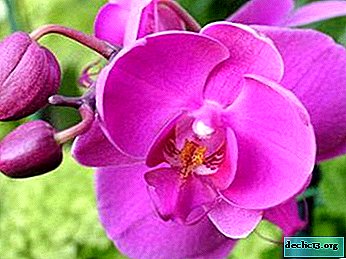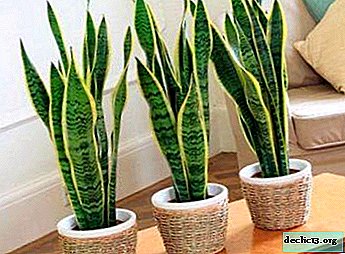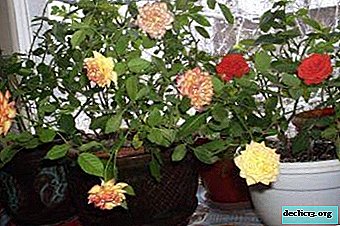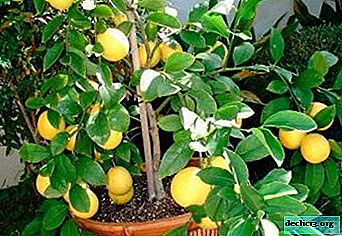The variety of titanopsis, especially the propagation of the flower and its care, as well as photo species

Amazing creation of nature, titanopsis, most of its life outwardly no different from cold stone, is transformed into a quivering tenderness, as soon as its first flowers blossom.
All lovers of combinations of incongruous uniquely charm this distinctive succulent. In this article we will consider the characteristics and description of this plant, its species. In the article, we will study in detail the methods of reproduction and transplantation of Titanopsis, describe and characterize the plant and talk about its diseases and pests.
Description and characteristics of the plant
Titanopsis is a succulent plant from the Aizoon family. It was discovered by Rudolph Marlot, a famous botanist, in 1907. In one of his expeditions to the stony desert of South Africa, the researcher leaned on a plant, crushing it, and only then realized that it was a living element of the landscape, and not a fragment of limestone in abundance around. So the succulent got its generic name titanopsis, which in Greek means "similar to lime."
The plant reaches a height of 3-6 cm, the texture is very similar to a mineral. A miniature rosette with a diameter of 9 cm is composed of gray-green, thick, short leaves. Their edges are thickened, flattened and covered with tubercles, warts and papillae.
In late August, flowers appear in the center of the outlet, up to 2 cm in diameter, bright yellow or orange.
Cultivation of titanopsis at home is not difficult. The plant is unpretentious and, subject to basic rules of care, is able to please the eye for decades. More information about reproduction, cultivation and care of “live stones” can be found here.
Views and their photos
Calzarea

In nature, Titanopsis calcarea is common in South Africa and Namibia (along the banks of the Orange River). This is a rosette leaf succulent that grows into ground cover pillows. Leaflets are shovel-shaped, reaching up to 2.5 cm in length. Colors can be from gray-green to brownish and buffy.
The ends of the leaves are flattened and abundantly covered with hard, rounded, differently sized tubercles of gray-white color with a reddish tinge. Leaflets are collected in a socket with a diameter of up to 8 cm. Flowers from yellow-orange to pinkish-flesh shades, about 2 cm in diameter. The flowering period falls on September-October.
Fuller

Miniature leaves - 2-2.2 cm in length, gray-green, sometimes reddish in color with not pronounced dark dots. The top is rounded triangular, the edge is framed by gray-brown warts. The underside is rounded, with a keel. Dark yellow flowers reach 1.6 cm in diameter. This species of titanopsis blooms in October-November.
Hugo Schlechteri

It differs from other types of titanopsis in that its foliage is slightly shiny. The plant forms rosettes of gray-green leaves with reddish tips, 1-1.5 cm long. The tops of the triangular leaves are densely covered with brown and red tubercles. Yellow or orange flowers appear in the winter-spring period.
This species is actively growing in winter. Guaranteed flowering is ensured if the flower managed to relax in the summer.
Primosia

Concentrated succulent, forming rooftop pillows with rosettes. Short, fleshy leaves with rounded ends are abundantly covered with warts. The color of the leaves is gray-white or brownish. Flowering occurs in the spring, yellowish-bodied flowers.
Schwantes

The plant forms basal rosettes with a width of about 10 cm and a height of 3 cm. The spoon-shaped leaves reach 3 cm in length. Rounded at the base and with three angles at the end, the leaves most often have a light gray-blue hue (sometimes reddish) with yellowish-brown cones . The flowers are light yellow, up to 2 cm in diameter.
You can learn more about other types of “living stones” and about caring for them here.
Home Care
- Lighting. Titanopsis prefers bright daylight and maximum heat. He needs such conditions to bloom. If the winter was not sunny, then with the advent of spring, the plant must be shaded for some time to prevent sunburn.
- Temperature. Titanopsis is loyal to temperature extremes. He is quite able to withstand fluctuations from +40 to frost. If the conditions are completely dry, then the plant will be able to survive at lower temperatures. But still, at home in the winter, it is optimal not to allow the thermometer to be below +12 degrees.
- The location. The optimal solution would be to place titanopsis on a south or southwest window. In summer, the plant is best kept outdoors.
- Watering. The combination of minimal watering and maximum amount of light is the secret to the success of growing titanopsis. Having received just such conditions, the plant expresses its decorativeness to the maximum, remaining compact and juicy. In nature, titanopsis grows near stones on which moisture condenses in the morning due to temperature differences. And these small doses are quite enough for the plant.
At home, most of the year, pebbles near the plant once a day in the morning need to be sprayed with water. In late spring and in the first half of summer, provided that the heat outside the window, you can slightly water it.
Attention! In the second half of summer, the plant enters a period of activity and needs more frequent, but not too plentiful watering, after each of which it is necessary to completely dry the soil. - Air humidity. Titanopsis is demanding on low humidity. This criterion becomes especially important if the plant has to survive low temperatures. The succulent will survive the minus values on the thermometer and dryness, but the combination of low temperatures and humidity will destroy it.
- Top dressing. Feeding is not necessary. In rare cases, you can use special compositions for cacti.
- The soil. At the bottom of the tank with titanopsis, high drainage is required. A mixture of sheet and turf soil should be permeable, and the composition of the substrate should include coarse sand and fine gravel (can be replaced with brick chips).
- Pruning. Titanopsis does not need scraps.
Breeding
Cuttings
 Reproduction is best done in early August.
Reproduction is best done in early August.
- A simple division, manually, forms a division, a prerequisite for which is the presence of three roots.
- The roots dry for about 3 hours.
- The division is planted in a dry substrate with a high content of sand in the composition.
Divided bushes are watered for the first time in 2-3 weeks.
The advantages of this method include the fact that Titanopsis divisions are a ready-made full-fledged plant. The only negative of this method of reproduction is that it requires the presence of an overgrown plant.
Seeds
Titanopsis seeds can be bought at a flower shop. Presowing seed preparation is not necessary, they are very tenacious, both fresh and stale. Titanopsis seeds are small, light brown or white, smooth or with a slightly noticeable texture.
The best time to plant is early spring. Sowing occurs according to the following scheme:
- Moisten the substrate. Without thickening, spread the seeds and deepen slightly.
- The seed tank is covered with film or glass and placed in a well-lit place, but without direct sunlight. For germination, it is necessary to maintain a temperature of +30 degrees.
- Ventilate crops daily for a short time.
- Two weeks later, when the shoots appear, open the plates.
- Conduct hydration until a third pair of leaves appears in the seedlings.
The popularity of this method of reproduction is due to accessibility, but cons include painstaking care for delicate seedlings, errors in moistening of which can lead to decay and death.
Transfer
The best time to transplant a titanopsis is July or August. It is carried out as the plants grow, on average once every three years.
The transplant is carried out according to the following scheme:
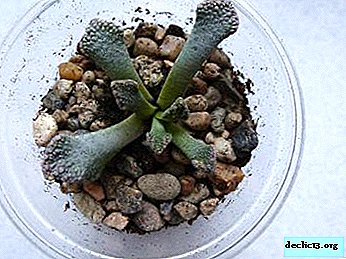 Soil preparation. You can take a ready-made substrate for cacti and succulents or cook it yourself by mixing half the humus with sand, small stones, vermiculite, broken shell rock or brick.
Soil preparation. You can take a ready-made substrate for cacti and succulents or cook it yourself by mixing half the humus with sand, small stones, vermiculite, broken shell rock or brick.- Pot preparation. Titanopsis has a very powerful core root, so the capacity should be deep and wide. Width is necessary for the plant to develop new rosettes.
- The plant is removed from the old pot, the roots are thoroughly cleaned of soil. If damaged or dead root processes are found, they should be removed.
- Titanopsis landed in new soil.
- The surface of the substrate is sprinkled with small pebbles.
Plant care after transplantation consists in the absence of watering in the first three weeks and maintaining good illumination in the room where titanopsis is contained.
Diseases and Pests
The plant is extremely resistant to ailments. If the watering is too plentiful, the roots and leaves may rot at Titanopsis. Occasionally affected by a spider mite.
Content difficulties
Titanopsis is strikingly unpretentious in leaving, so, as a rule, difficulties with its content do not arise. The plant can only die due to overflows and wilt if the light regime is not observed.
Important! Sunlight should abundantly fall on the plant, but not heat the pot. A daily large stream of fresh air is crucial for the healthy development of Titanopsis. The room where it is located should be regularly ventilated.Conclusion
Due to its miniature size and variety of species, titanopsis allows you to organize a whole garden in a small space. The originality of the forms, combined with the ease of cultivation, make the plant a welcome guest in many homes.

 Soil preparation. You can take a ready-made substrate for cacti and succulents or cook it yourself by mixing half the humus with sand, small stones, vermiculite, broken shell rock or brick.
Soil preparation. You can take a ready-made substrate for cacti and succulents or cook it yourself by mixing half the humus with sand, small stones, vermiculite, broken shell rock or brick.



